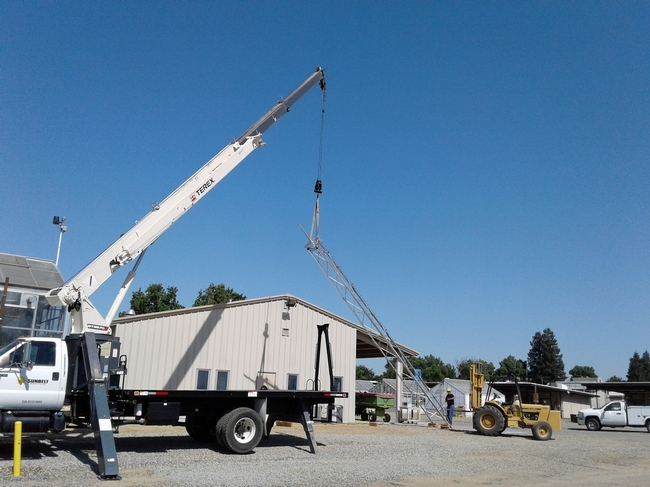The dizzying impact of the digital revolution on many sectors of society – from retail to law enforcement, politics and entertainment – has also altered the picture on California farms.
With technology, farmers have found ways to reduce pesticide use, increase irrigation efficiency, reduce travel into the fields, manage people better, and deal with labor shortages. Much more can be done.
To connect farmers interested in ag innovations with researchers who can confirm the potential of new technologies, UC Agriculture and Natural Resources created Verde Innovation Network for Entrepreneurship, or the VINE. The program has launched a website at https://thevine.io, a place for farmers, food entrepreneurs, researchers and technology professionals to find the resources they need to build, launch and grow agricultural innovations.
“The VINE brings together academia across UC, the Cal-State University system, and community colleges with innovators in technologies like artificial intelligence, machine learning, robotics, indoor agriculture and others,” said Gabe Youtsey, UC ANR chief innovation officer. “We want to create rural testbeds to develop technology. UC ANR's research and extension centers are well set up to do that.”
UC ANR has research and extension centers (RECs) across California, in locations representative of different agricultural ecosystems – from the desert southwest to the intermountain region near the Oregon border. The VINE recently invited technology companies and farmers to the UC Kearney Agricultural Research and Extension Center in Parlier to mark the installation of a wifi tower that will bathe the 330-acre agricultural research station in high-speed wireless internet.
The project built on the partnership with the Corporation for Education Network Initiatives in California (CENIC) that brought ultra-fast (100Gbps) broadband capability to Kearney offices and laboratories two years ago. UC ANR collaborated with Orange Silicon Valley and BlueTown to extend the connectivity via wireless transmission to every corner of the research fields.
Orange Silicon Valley is a division of Orange in France, a telecommunications provider. BlueTown, based in Denmark, provides low-cost, sustainable wifi to people in rural areas around the world.
The wifi update enables researchers at Kearney to collect and view data without any delay.
“Now we can do real-time data collection,” said Jeff Dahlberg, Kearney director. “We need science to back up technology. We can use Kearney to ground-truth new technologies before farmers make a decision to buy into it.”
Internet access may not be critical to farming at the moment, but as growers adopt more technology-driven applications on their farms, a fast, reliable and widespread internet will be imperative.
“We're setting a foundation for the future,” Youtsey said. “The innovation infrastructure to really create the solutions and tie them together is broadband.”
The wireless system serves as a model and possible resource for rural communities interested in offering high-speed internet to residents. The Kearney wifi offers benefits to the partners that helped make it a reality. Orange Silicon Valley is working on bringing internet to remote places in Africa and India.
“They wanted a test facility, a place and a relationship for research and development in their backyard,” Youtsey said. “We have conditions at Kearney that are similar to the rural areas around the world where they work.”
Kearney was the first UC ANR REC to be equipped with connectivity to serve as a field innovation center.
“Eventually, multiple centers across California will have the infrastructure to test and evaluate technology in the places where food grows in California,” Youtsey said. “Robots are starting to come out of the lab and need to be tested in farm fields pruning fruit trees, suckering grapes, harvesting crops. As these technologies are developed, we have great facilities with almost infinite flexibility, compared to commercial farms. We can demonstrate these new technologies for farmers.”
The VINE is working with the Western Growers Association – which brings together farmers in Arizona, California, Colorado and New Mexico to support common goals – and the organization's new Center for Innovation and Technology. WGA hosts regular AgTechx sessions in which farmers and ag entrepreneurs share ideas, innovations, issues and concerns regarding technology. At a recent Coalinga meeting, a farmer panel presented problems for which they are seeking technological solutions.
- With new regulations from California's Sustainable Groundwater Management Act, farmers need to find a way to measure how much water they are applying and how much of that water is recharging the aquifer, said William Bourdeau of Harris Ranch.
- “Food safety keeps me up at night. We need better supply chain data,” said Garrett Patricio of Westside Produce.
- “We're using mid-20th century technology on the farm. There's a tremendous problem with connectivity. It starts with that,” Patricio said.
- If robots and other technology are deployed on farms, producers need reliable tech support to prevent lengthy stoppages, which can have devastating economic impacts, said Patricio.
- Pistachios are alternate bearing. “We need to have a way to know which trees don't need as much water,” said Richard Mataion of the California Pistachio Commission.
Farmer Don Cameron of Terranova Ranch said agriculture has already come a long way, implementing moisture monitoring sensors, consulting aerial photos of the crop, and equipping irrigation managers with tablet computers.
“If the technology is profitable, and we can make it work, it will catch on,” he said.

